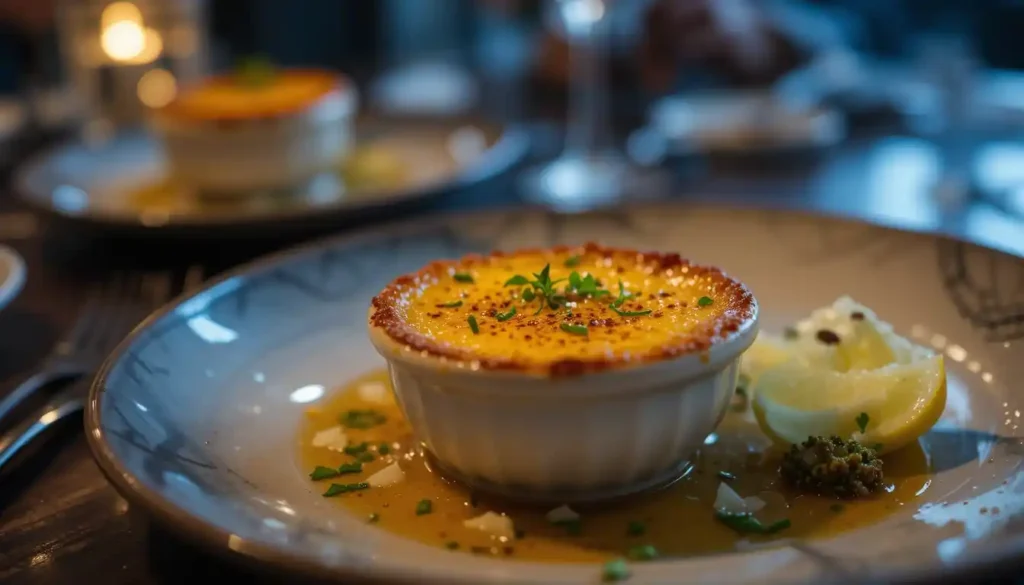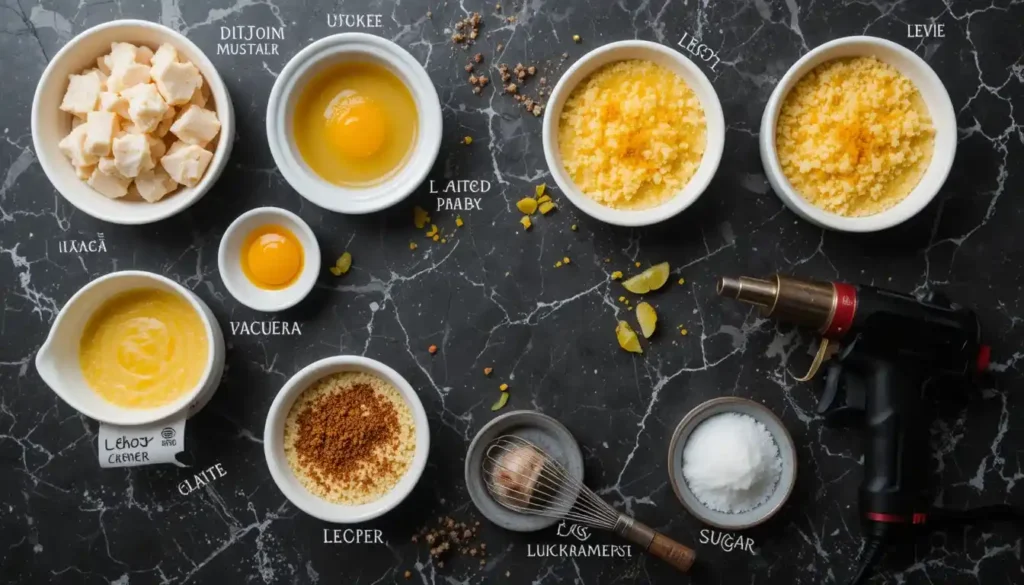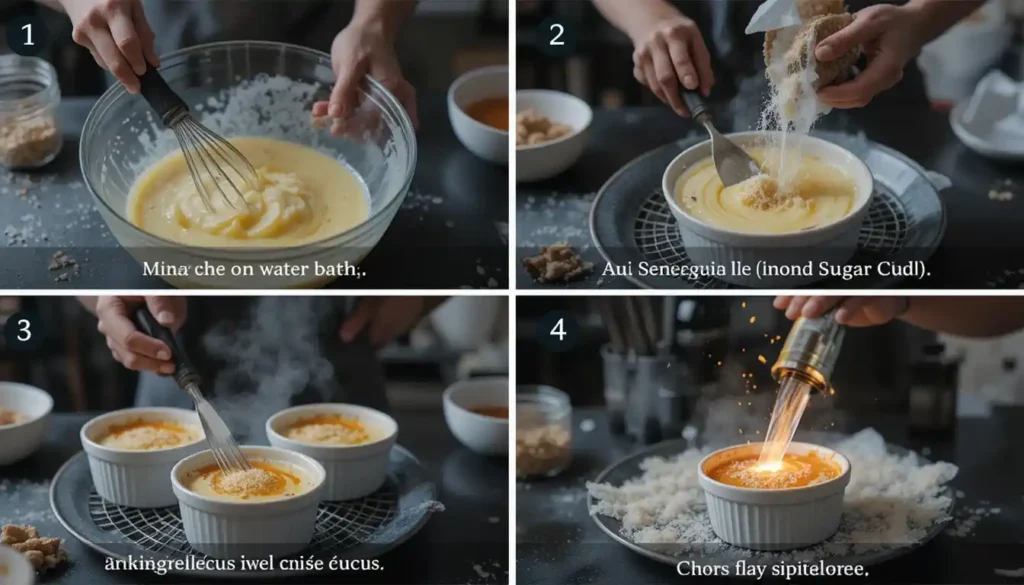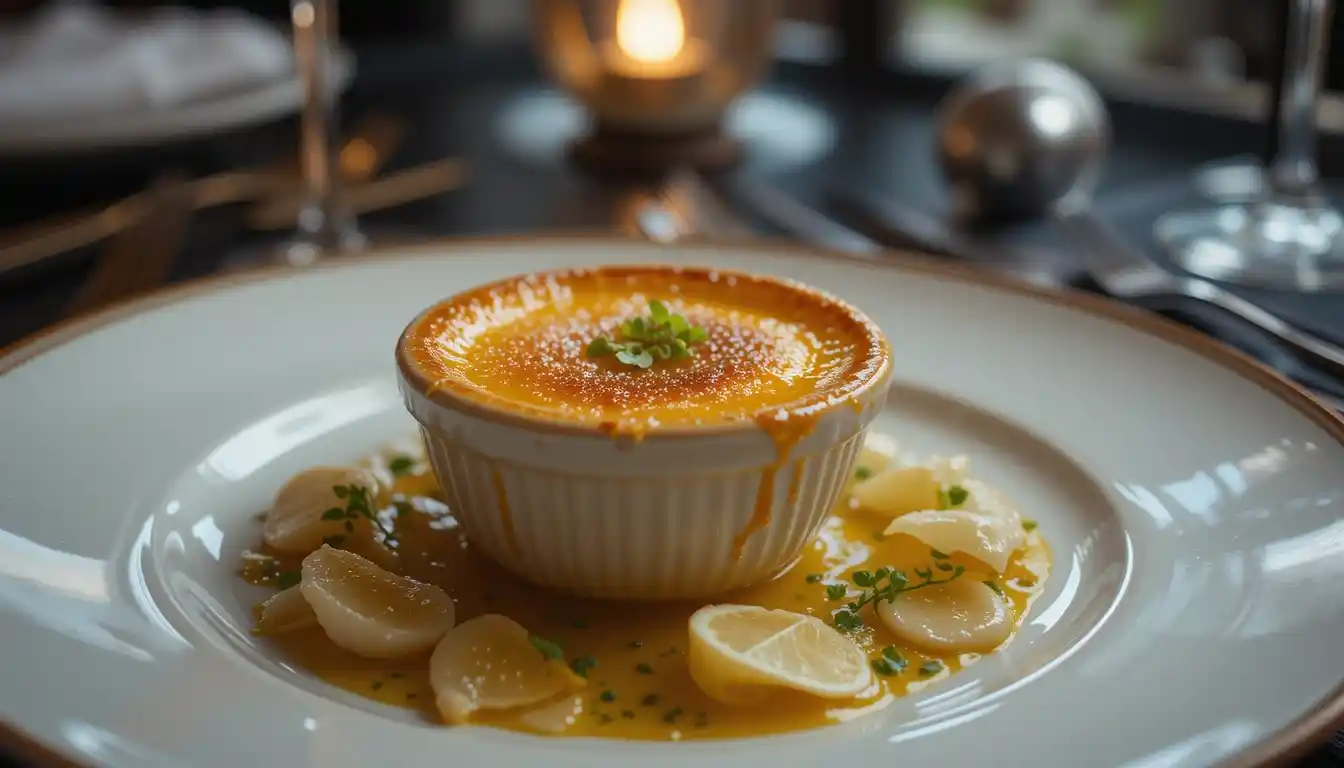Table of Contents
As the celebrated chef, Thomas Keller, once said, “The best food is street food, and the best restaurant is the one that feels like you’re eating in someone’s home.” This crab crème brûlée recipe embodies that spirit, transforming a classic dessert into a sophisticated dish that will tantalize your taste buds.
The rich custard, infused with the sweetness of crab meat, is topped with a layer of caramelized sugar, creating a delightful contrast of textures. This innovative fusion of flavors and techniques will elevate your dining experience, making it perfect for dinner parties or special occasions.

The Story Behind Crab Brûlée
You might be surprised to learn that the story of crab brûlée begins with a traditional French dessert. The history of crème brûlée is as rich as the dessert itself, with its origins tracing back to 17th century France.
From Classic Dessert to Savory Delight
The first documented crème brûlée recipe appeared in François Massialot’s 1691 cookbook. While France claims its origins, similar custard-based dishes were enjoyed across Europe during the 17th century. The traditional dessert has evolved over centuries, maintaining its signature contrast between smooth custard and crackling caramelized sugar.
Why This Fusion Dish Works So Well
The transformation from sweet dessert to savory crab brûlée represents culinary innovation that respects classical techniques while creating something entirely new. The natural sweetness of crab meat pairs harmoniously with the rich custard base, while the caramelized top adds a complementary dimension that enhances the seafood flavor. This fusion dish works exceptionally well because it maintains the textural contrast that makes traditional crème brûlée so beloved while introducing complex savory notes.
Selecting the Perfect Crab Meat
To create an exceptional Crab Brûlée, it’s essential to understand the different types of crab meat available. The right crab meat can elevate the dish, providing a rich and indulgent flavor profile.
Types of Crab and Their Flavor Profiles
Various types of crab meat offer distinct characteristics that can significantly impact the final dish. Blue crab meat is known for its delicate sweetness and tender texture, making it perfect for dishes that require a tender touch. Dungeness crab meat offers a meatier texture with just a hint of sweetness, ideal for recipes that need a bit of oomph. King Crab meat brings a luxurious, rich flavor and substantial texture, creating an indulgent version of Crab Brûlée. Lastly, Snow Crab meat provides a fine texture with subtle sweetness that integrates seamlessly into the custard base.
| Crab Type | Flavor Profile | Texture |
|---|---|---|
| Blue Crab | Delicate sweetness | Tender |
| Dungeness Crab | Meaty with hint of sweetness | Meatier |
| King Crab | Rich flavor | Substantial |
| Snow Crab | Subtle sweetness | Fine |
Fresh vs. Frozen vs. Canned
The choice between fresh, frozen, and canned crab meat is crucial. Fresh crab meat delivers unmatched flavor and texture, though high-quality frozen crab can be a practical alternative. Canned crab, while convenient, typically lacks the texture and flavor complexity needed for Crab Brûlée, making it best suited for recipes where crab plays a supporting role.
Essential Ingredients for Crab Brûlée Recipe
The foundation of a luxurious crab brûlée lies in its ingredients. To create this delightful dish, you’ll need to focus on both the quality and the combination of the components.

The Custard Base Components
The custard base is a crucial element of crab brûlée, providing the rich and creamy texture that complements the crab meat. For this, you’ll need heavy cream with at least 36% fat content, ensuring a silky texture. 2 large egg yolks and 1 large whole egg are essential for achieving the perfect custard consistency. The eggs provide the necessary fat and protein for a smooth set.
Seasonings and Flavor Enhancers
To enhance the flavor of your crab brûlée, several seasonings and ingredients are key. White pepper is preferred over black pepper as it maintains the custard’s appearance while adding a subtle heat. Salt is also crucial but should be used judiciously, considering the natural salinity of the crab meat. Additional flavor enhancers include finely chopped pickled ginger, garlic, and grated parmesan cheese, which add complexity without overwhelming the crab flavor.
| Ingredient | Quantity | Purpose |
|---|---|---|
| Crab Meat | 150 grams, picked | Main ingredient providing the delicate crab flavor |
| Single Cream | 400 ml | Creates the rich and creamy custard base |
| Egg Yolks | 2 large | Essential for custard consistency and richness |
| Whole Egg | 1 large | Adds to the custard’s texture and richness |
| Pickled Ginger | 1/2 tablespoon, finely chopped | Adds a tangy, complex flavor |
| Garlic | 1 clove, finely chopped | Enhances the overall flavor profile |
| Parmesan Cheese | 2 tablespoons, grated | Contributes a savory, umami taste |
As noted by culinary experts, “The quality of each ingredient significantly impacts the final result, so using the freshest components available is crucial for the most luxurious crab brûlée.” This attention to detail ensures a superior dining experience.
Step-by-Step Preparation Guide
To create a delightful Crab Brûlée, follow this step-by-step preparation guide carefully. The process involves creating a rich custard base, incorporating high-quality crab meat, and baking it to perfection.

Creating the Perfect Custard Base
Begin by preparing your ingredients and bringing them to room temperature. In a large bowl, whisk egg yolks until smooth, then gradually incorporate the cream mixture. Heat the cream with seasonings until small bubbles form around the edges, being careful not to let it boil completely.
Incorporating the Crab Meat
Once your custard mixture is ready, gently fold in your selected crab meat. Ensure the mixture is well combined and the crab meat is evenly distributed.
Baking and Setting Techniques
Pour the mixture into ramekins and place them in a roasting tray. Fill the tray with warm water halfway up the sides of the ramekins. Preheat oven to 300℉ and bake for 45 to 60 minutes until the custard achieves a wobbly consistency.
By following these steps, you’ll be able to create a delicious Crab Brûlée with a perfectly cooked custard and a generous amount of crab meat. The key is to be patient and monitor the baking time closely to achieve the desired texture.
Mastering the Caramelization Process
The art of caramelization is what elevates your crab brûlée from a simple custard to a culinary masterpiece. This crucial step adds a textural contrast and a rich flavor that complements the creamy crab custard.
To achieve the perfect caramelized top, you need to follow a few key steps. First, ensure that your custards are properly chilled and dry the surface to prevent any moisture from interfering with the caramelization process. Sprinkle a thin, even layer of granulated sugar across the top of each custard. Too much sugar can result in a bitter, thick crust, while too little won’t provide the desired crackle.
Torch Techniques for the Perfect Crust
When using a kitchen torch, hold it at a slight angle and move it in small circular motions to achieve an even caramelization without burning. The goal is to get a deep amber color that provides a satisfying crack when broken with a spoon. This technique requires some practice, but the result is well worth the effort.
Alternative Methods Without a Kitchen Torch
If you don’t have a kitchen torch, you can use your oven’s broiler as an alternative. Place the ramekins on the top rack and watch carefully to prevent burning. Rotate the ramekins frequently to ensure even caramelization across the entire surface. Some chefs also prefer a double-caramelization technique for extra crunch.
| Caramelization Method | Equipment Needed | Tips for Success |
|---|---|---|
| Kitchen Torch | Kitchen torch, granulated sugar | Move torch in circular motions, aim for deep amber color |
| Oven Broiler | Oven, granulated sugar | Rotate ramekins frequently, watch closely to prevent burning |
| Double Caramelization | Kitchen torch or oven broiler, granulated sugar | Apply thin layer of sugar, torch or broil, then add second layer for extra crunch |
Regardless of the method you choose, allow the caramelized sugar to set for 1-2 minutes before serving. This ensures the perfect contrast between the hard top and creamy custard. With practice, you’ll master the caramelization process and elevate your crab brûlée to new heights.
Expert Tips for a Flawless Crab Brûlée
For a truly exceptional crab brûlée experience, follow these expert guidelines to ensure success. Achieving perfection in this dish requires attention to detail and a understanding of the key elements that make it shine.
Temperature Control Secrets
Temperature control is crucial throughout the crab brûlée-making process. Ensure that your ingredients are at room temperature before mixing, and maintain the proper water bath temperature during baking. This attention to temperature will help you achieve a silky smooth custard.
Texture Troubleshooting
If your custard appears curdled, it’s likely due to overheating or adding hot cream too quickly to the egg yolks. To avoid this, focus on gentle, slow temperature changes. For custards that won’t set properly, check your oven temperature accuracy and consider extending the baking time slightly.
Make-Ahead and Storage Options
The make-ahead potential of crab brûlée makes it perfect for entertaining. You can prepare the custard up to 24 hours in advance and caramelize just before serving. Store uncaramelized custards in the refrigerator, covered tightly with plastic wrap, and never store crab brûlée after caramelizing the top.
| Preparation Step | Timing | Storage Tip |
|---|---|---|
| Prepare Custard | Up to 24 hours in advance | Refrigerate, covered |
| Caramelize Sugar | Just before serving | Avoid storing after caramelization |
| Serve | 15-20 minutes after refrigeration | Allow to sit at room temperature |
Serving Suggestions and Pairings
The key to a memorable crab brûlée experience lies not just in its preparation but also in how it’s served and paired. When presenting this dish, consider the overall dining experience you want to create.
Complementary Side Dishes
Crab brûlée can be served as an elegant appetizer in individual ramekins or as a show-stopping main course in larger portions. For a complete appetizer presentation, serve it alongside thinly sliced, lightly toasted baguette or artisanal crackers. A simple side salad with citrus vinaigrette also complements the richness of the dish while providing refreshing acidity.
- For an appetizer, pair with toasted baguette or crackers.
- For a main course, consider asparagus, haricots verts, or a light fennel salad.
Wine and Beverage Recommendations
When it comes to drinks, a crisp white wine like Pinot Grigio or Sauvignon Blanc pairs perfectly with crab brûlée. The citrus notes in these wines complement the delicate flavors of the crab without overwhelming them. For beer enthusiasts, a light-bodied Belgian ale or wheat beer offers complementary flavors.
| Beverage | Description |
|---|---|
| Pinot Grigio | Crisp and refreshing, complements delicate crab flavors. |
| Sauvignon Blanc | Citrus notes enhance the dish’s freshness. |
| Belgian Ale | Light-bodied, offers complementary flavors without overpowering the crab. |
Allow your guests about 15 minutes to enjoy the contrast between the warm, freshly caramelized top and the cool custard beneath.
Conclusion
As you master the art of Crab Brûlée, you’ll discover a world of flavors that blend the richness of crab meat with the elegance of French cuisine. This creme brulee recipe is not just a dish; it’s an experience that combines the silky custard with the crunch of caramelized sugar. With heavy cream, fresh eggs, and quality crab meat, such as Dungeness crab, you’ll create a truly memorable meal. Whether you’re cooking for yourself or impressing guests, this crab brulee recipe is sure to delight.
FAQ
What type of crab is best suited for crab brûlée?
Dungeness crab is a popular choice due to its sweet flavor and tender texture, making it ideal for this dish.
Can I use canned crab meat instead of fresh crab?
While fresh crab is preferred for its flavor and texture, canned crab meat can be used as a substitute in a pinch. However, be sure to drain the liquid and pat dry the meat before using.
How do I achieve the perfect caramelized sugar on top?
To get a perfectly caramelized sugar crust, use a kitchen torch to carefully caramelize the sugar in a circular motion, or place the ramekins under the broiler for a short time, watching closely to avoid burning.
What is the ideal temperature for baking the custard mixture?
Preheat your oven to 325°F (165°C) and bake the custard mixture until it’s set and slightly jiggly in the center.
Can I prepare the crab brûlée ahead of time?
Yes, you can prepare the custard mixture and store it in the refrigerator overnight, then bake and caramelize the sugar just before serving.
How do I prevent the custard from curdling during baking?
To prevent curdling, make sure to temper the egg yolks by slowly pouring the warm cream mixture into the eggs, whisking constantly, and bake the custard in a water bath to maintain a stable temperature.


1 thought on “Creamy Crab Brûlée: A Delightful Fusion of Flavors”
Comments are closed.